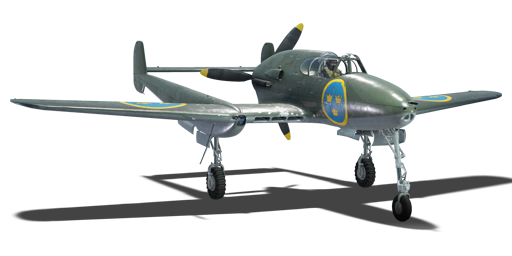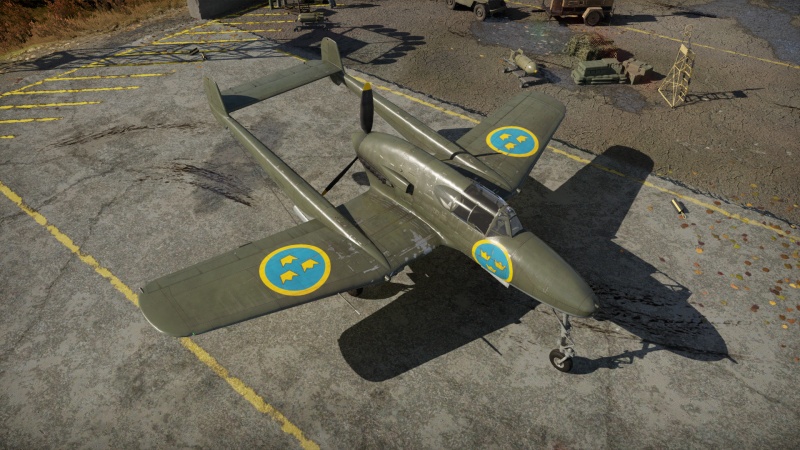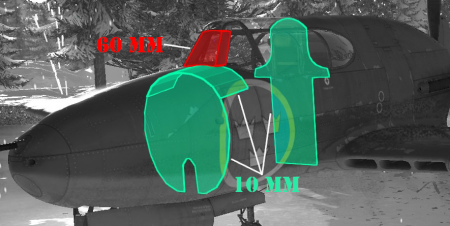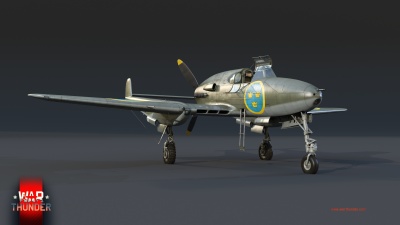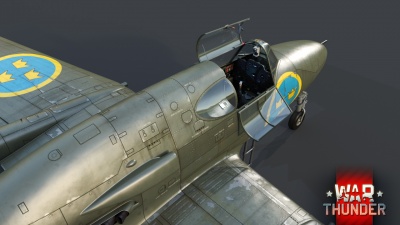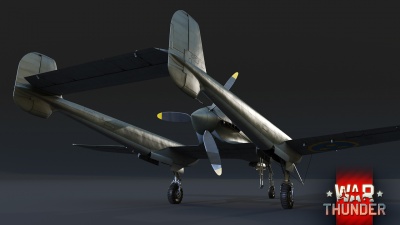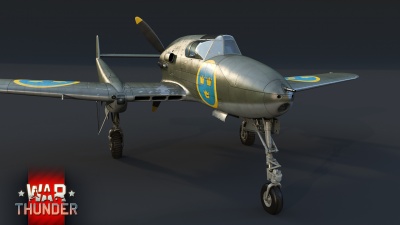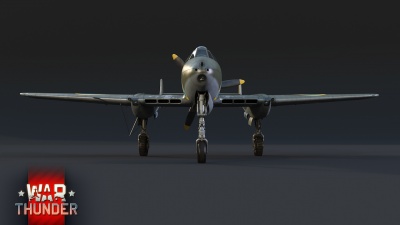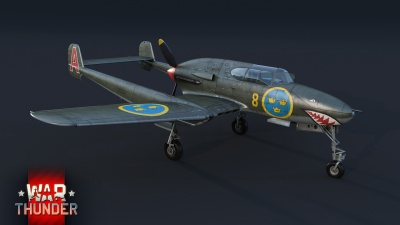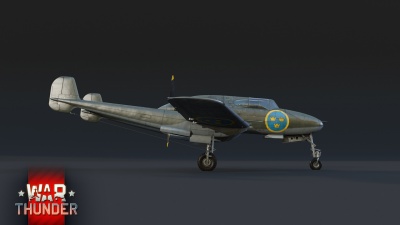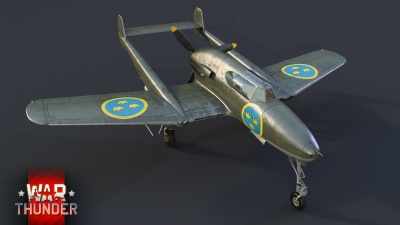Difference between revisions of "J21A-1"
Inceptor57 (talk | contribs) m (→Pros and cons) |
m (the XP-50 is added as a notable target to watch out for.) (Tag: Visual edit) |
||
| (41 intermediate revisions by 23 users not shown) | |||
| Line 1: | Line 1: | ||
| − | |||
{{About | {{About | ||
| about = Swedish fighter '''{{PAGENAME}}''' | | about = Swedish fighter '''{{PAGENAME}}''' | ||
| usage = other versions | | usage = other versions | ||
| link = J21 (Family) | | link = J21 (Family) | ||
| + | }} | ||
| + | {{Specs-Card | ||
| + | |code=saab_j21a_1 | ||
| + | |images={{Specs-Card-Image|GarageImage_{{PAGENAME}}.jpg}} | ||
| + | |cockpit=cockpit_saab_j21a_1.jpg | ||
}} | }} | ||
== Description == | == Description == | ||
<!-- ''In the description, the first part should be about the history of and the creation and combat usage of the aircraft, as well as its key features. In the second part, tell the reader about the aircraft in the game. Insert a screenshot of the vehicle, so that if the novice player does not remember the vehicle by name, he will immediately understand what kind of vehicle the article is talking about.'' --> | <!-- ''In the description, the first part should be about the history of and the creation and combat usage of the aircraft, as well as its key features. In the second part, tell the reader about the aircraft in the game. Insert a screenshot of the vehicle, so that if the novice player does not remember the vehicle by name, he will immediately understand what kind of vehicle the article is talking about.'' --> | ||
| − | + | The SAAB 21 rose from the drawing board in anticipation of World War 2. The development of this aircraft came with the need to develop a national fighter without having to rely on foreign designs like the Re.2000 and CR.42. The Saab 21's unique twin-boom layout, offering exceptional pilot visibility and easy maintenance, was chosen and fitted with a modified German Daimler-Benz DB 605 engine. Despite missing wartime action, the Saab 21 remained relevant, with over 300 produced to bolster Sweden's air defenses. | |
| − | + | ||
| − | The ' | + | Introduced in [[Update 1.95 "Northern Wind"]] along with the initial Swedish air tree, the J21A-1 is quite sluggish but a heavily durable fighter. It has a top speed of 640 km/h, courtesy of the Daimler-Benz DB 605B engine; however, the speed and manoeuvrability are not the most impressive characteristics of the aircraft: it's the weaponry it comes armed with. A total of four 13.2 mm [[Akan m/39A (13.2 mm)|Akan m/39A]] and a 20 mm [[Akan m/41A (20 mm)|Akan m/41A]] makes it a heavy firepower-reliant fighter able to eliminate any enemy aircraft with ease. |
== General info == | == General info == | ||
=== Flight performance === | === Flight performance === | ||
| + | {{Specs-Avia-Flight}} | ||
<!-- ''Describe how the aircraft behaves in the air. Speed, manoeuvrability, acceleration and allowable loads - these are the most important characteristics of the vehicle.'' --> | <!-- ''Describe how the aircraft behaves in the air. Speed, manoeuvrability, acceleration and allowable loads - these are the most important characteristics of the vehicle.'' --> | ||
| − | The J21 series is arguably the most iconic propeller-engined aircraft to ever come out of Sweden. Its distinctive twin-boom, rear-engined | + | The J21 series is arguably the most iconic propeller-engined aircraft to ever come out of Sweden. For the time, they were underpowered, slow aircraft that were outclassed by nearly all opponents it could have faced. Its distinctive twin-boom, rear-engined fascia is easy to recognize and its performance is nothing to scoff at either, though the climb rate is poor and the engine overheats quickly when using WEP. The [[Akan m/39A (13.2 mm)|Akan m/39A]]'s are some of the most effective non-cannon aircraft weaponry in the game, boasting superior aspects to even the famed [[M2 Browning (12.7 mm)|M2 Browning]], specifically in terms of raw stopping power and muzzle velocity. The [[Akan m/41A (20 mm)|Akan m/41A]]'s are quite powerful as well. The challenge for the pilot is to manoeuvre this aircraft into a solid shooting solution which can be difficult especially against more agile aircraft. Although suffering from a relatively low rip speed, skilled and new pilots can use this somewhat to their advantage, mainly by diving on opponents and climbing again, although this shouldn't be attempted at extreme speeds. |
| − | |||
| − | |||
{| class="wikitable" style="text-align:center" width="70%" | {| class="wikitable" style="text-align:center" width="70%" | ||
| Line 59: | Line 62: | ||
! Combat !! Take-off !! Landing !! + !! - | ! Combat !! Take-off !! Landing !! + !! - | ||
|- | |- | ||
| − | | {{Specs|destruction|body}} || {{Specs|destruction|gear}} || | + | | {{Specs|destruction|body}} || {{Specs|destruction|gear}} || 445 || 425 || 325 || ~11 || ~5 |
| + | |- | ||
| + | |} | ||
| + | |||
| + | {| class="wikitable" style="text-align:center" | ||
| + | |- | ||
| + | ! colspan="4" | Optimal velocities (km/h) | ||
| + | |- | ||
| + | ! Ailerons !! Rudder !! Elevators !! Radiator | ||
| + | |- | ||
| + | | < 450 || < 390 || < 420 || > 715 | ||
|- | |- | ||
|} | |} | ||
=== Survivability and armour === | === Survivability and armour === | ||
| + | [[File:J21 Armour Plating.png|450px|thumb|right|Protective components found in the '''{{PAGENAME}}'''.]] | ||
| + | {{Specs-Avia-Armour}} | ||
<!-- ''Examine the survivability of the aircraft. Note how vulnerable the structure is and how secure the pilot is, whether the fuel tanks are armoured, etc. Describe the armour, if there is any, and also mention the vulnerability of other critical aircraft systems.'' --> | <!-- ''Examine the survivability of the aircraft. Note how vulnerable the structure is and how secure the pilot is, whether the fuel tanks are armoured, etc. Describe the armour, if there is any, and also mention the vulnerability of other critical aircraft systems.'' --> | ||
| − | |||
* 10 mm steel - Firewall armour plate | * 10 mm steel - Firewall armour plate | ||
| Line 71: | Line 85: | ||
* 10 mm steel - Pilot's back armour plate | * 10 mm steel - Pilot's back armour plate | ||
* 60 mm bulletproof glass | * 60 mm bulletproof glass | ||
| + | * Engine fire system (EFS) | ||
| + | |||
| + | === Modifications and economy === | ||
| + | {{Specs-Economy}} | ||
== Armaments == | == Armaments == | ||
| + | {{Specs-Avia-Armaments}} | ||
=== Offensive armament === | === Offensive armament === | ||
| + | {{Specs-Avia-Offensive}} | ||
<!-- ''Describe the offensive armament of the aircraft, if any. Describe how effective the cannons and machine guns are in a battle, and also what belts or drums are better to use. If there is no offensive weaponry, delete this subsection.'' --> | <!-- ''Describe the offensive armament of the aircraft, if any. Describe how effective the cannons and machine guns are in a battle, and also what belts or drums are better to use. If there is no offensive weaponry, delete this subsection.'' --> | ||
{{main|Akan m/41A (20 mm)|Akan m/39A (13.2 mm)}} | {{main|Akan m/41A (20 mm)|Akan m/39A (13.2 mm)}} | ||
| Line 83: | Line 103: | ||
* 2 x 13.2 mm Akan m/39A machine guns, wing-mounted (325 rpg = 650 total) | * 2 x 13.2 mm Akan m/39A machine guns, wing-mounted (325 rpg = 650 total) | ||
| − | The | + | The automatkanon m/41A is essentially a slower firing [[Hispano 404 (20 mm)|Hispano 404]] with more ammunition, with all the advantages and disadvantages that come with it. While one might think that the slower firing speed is a disadvantage, it is just high enough to still be effective and is very beneficial for conserving ammunition. When stock, the cannon is very inaccurate and overheats quickly, but becomes quite accurate after modifications. |
| − | The complimentary | + | The complimentary automatkanon m/39A heavy machine guns are, as mentioned previously, arguably the best non-cannon weapons in the game. Their high muzzle velocity, very high fire rate and reasonable accuracy allow them to saturate the sky with lead. The higher calibre of 13.2 mm allows for more stopping power than the typical 12.7 mm and converts them from just being a nuisance to a threat to be heeded. It is interesting to note that due to their HEF-T rounds, they technically fall under the category of "cannon", as normally exploding rounds typically start at 20 mm. |
== Usage in battles == | == Usage in battles == | ||
<!-- ''Describe the tactics of playing in the aircraft, the features of using aircraft in a team and advice on tactics. Refrain from creating a "guide" - do not impose a single point of view, but instead, give the reader food for thought. Examine the most dangerous enemies and give recommendations on fighting them. If necessary, note the specifics of the game in different modes (AB, RB, SB).'' --> | <!-- ''Describe the tactics of playing in the aircraft, the features of using aircraft in a team and advice on tactics. Refrain from creating a "guide" - do not impose a single point of view, but instead, give the reader food for thought. Examine the most dangerous enemies and give recommendations on fighting them. If necessary, note the specifics of the game in different modes (AB, RB, SB).'' --> | ||
| − | + | The J21A-1 (along with the rest of the J21A variants) is an excellent energy fighter. The plane retains and gains speed very well, as long as it is flying in a straight line. In level flight or in a dive, the J21A is very fast and can outrun most of its opponents. Additionally, it can maneuver quite well compared to some of its opponents but pilots must watch to ensure their speed does not drop too low as this makes the J21A an easy target. The nose-mounted armament makes it possible to successfully fight head-on with opponents and the 20 mm cannon is especially devastating when combined with the 13.2 mm machine guns. This armament also makes the J21A good as a bomber-interceptor since it can knock out critical components of an opponent's aircraft very quickly. | |
| + | |||
| + | Overall, the J21A was designed (and should be used) as an interceptor. One excellent tactic is to climb at about 20 degrees until reaching 4,000-5,000 m and operating from that altitude in a boom-and-zoom role. This enables the J21A to use its excellent dive speed and heavy armament to maximum effect. | ||
| − | + | Another effective tactic is to fly level and fast at medium altitude 2,000-3,000 m and act as a support fighter, assisting team mates who are overwhelmed by picking off some of their opponents in hit-and-run attacks. While the J21 can maneuver quite well (especially with combat flaps) it is not advisable to do this except as a last resort because the aircraft bleeds speed very rapidly. Also, this can expose the J21's engine (mounted in the rear of the aircraft) to and an enemy, allowing him the opportunity to knock out the J21's engine or hit its fuel tank (centrally located between the cockpit and the engine). This is another reason to avoid running away from an opponent, except when you can dive faster than the enemy or outclimb him. Many planes at the J21's level can keep up with it, although many also cannot. As long as you know your opponent and their capabilities, you can use the J21 very effectively. | |
| − | + | Although the J21 can be set on fire rather easily due to its centrally located fuel tank, it is often possible to put out the fire by diving very steeply and fast. This creates enough of a slipstream around the fuselage to often put out the fire. | |
| − | + | A enemy worth noting is the F-82E which is equipped with 6 12.7 mm M3 Browning machine guns which could provide a formidable foe that could take out the J21A quickly with just a few bursts, and its payload is superior to the J21 variants, which could result in a quick death when going head on with one. Another plane of interest that needs not be ignored is the XP-50, which has an airspawn and will most likely have an energy advantage over you, be careful while dealing with such planes. | |
| − | |||
| − | |||
=== Manual Engine Control === | === Manual Engine Control === | ||
| Line 113: | Line 133: | ||
|- | |- | ||
| Not controllable || Controllable<br>Auto control available || Controllable<br>Auto control available || Controllable<br>Auto control available || Separate || Not controllable<br>1 gear || Not controllable | | Not controllable || Controllable<br>Auto control available || Controllable<br>Auto control available || Controllable<br>Auto control available || Separate || Not controllable<br>1 gear || Not controllable | ||
| − | |||
| − | |||
| − | |||
| − | |||
| − | |||
| − | |||
| − | |||
| − | |||
| − | |||
| − | |||
| − | |||
| − | |||
| − | |||
| − | |||
| − | |||
| − | |||
| − | |||
| − | |||
| − | |||
| − | |||
| − | |||
| − | |||
| − | |||
| − | |||
| − | |||
| − | |||
| − | |||
| − | |||
| − | |||
| − | |||
| − | |||
| − | |||
| − | |||
| − | |||
| − | |||
| − | |||
| − | |||
|- | |- | ||
|} | |} | ||
| Line 158: | Line 141: | ||
'''Pros:''' | '''Pros:''' | ||
| − | * | + | * Heavy armament with excellent ammunition belts, with most of it being nose-mounted |
| − | + | * Retains controllability at all speeds, even when stalling | |
| − | * | + | * Can pull high AoA for quick snapshots |
| − | * Can | ||
| − | |||
| − | |||
| − | |||
'''Cons:''' | '''Cons:''' | ||
| − | * | + | * Loses energy rapidly in sharp turns |
| − | + | * Engine overheats during takeoff and during flight at WEP even with full modifications | |
| − | |||
| − | |||
| − | * Engine overheats during takeoff | ||
* Very low rip speed - cannot push past 640 km/h (400 mph) without threatening to rip off wings | * Very low rip speed - cannot push past 640 km/h (400 mph) without threatening to rip off wings | ||
== History == | == History == | ||
<!-- ''Describe the history of the creation and combat usage of the aircraft in more detail than in the introduction. If the historical reference turns out to be too long, take it to a separate article, taking a link to the article about the vehicle and adding a block "/History" (example: <nowiki>https://wiki.warthunder.com/(Vehicle-name)/History</nowiki>) and add a link to it here using the <code>main</code> template. Be sure to reference text and sources by using <code><nowiki><ref></ref></nowiki></code>, as well as adding them at the end of the article with <code><nowiki><references /></nowiki></code>. This section may also include the vehicle's dev blog entry (if applicable) and the in-game encyclopedia description (under <code><nowiki>=== In-game description ===</nowiki></code>, also if applicable).'' --> | <!-- ''Describe the history of the creation and combat usage of the aircraft in more detail than in the introduction. If the historical reference turns out to be too long, take it to a separate article, taking a link to the article about the vehicle and adding a block "/History" (example: <nowiki>https://wiki.warthunder.com/(Vehicle-name)/History</nowiki>) and add a link to it here using the <code>main</code> template. Be sure to reference text and sources by using <code><nowiki><ref></ref></nowiki></code>, as well as adding them at the end of the article with <code><nowiki><references /></nowiki></code>. This section may also include the vehicle's dev blog entry (if applicable) and the in-game encyclopedia description (under <code><nowiki>=== In-game description ===</nowiki></code>, also if applicable).'' --> | ||
| − | The SAAB 21 is a twin-boom pusher fighter and attacker designed by the famed Swedish engineer Frid Wänström | + | The SAAB 21 is a twin-boom pusher fighter and attacker designed by the famed Swedish engineer Frid Wänström, who also worked on the SAAB 29 ''Tunnan'', 32 ''Lansen'', 35 ''Draken'' and 37 ''Viggen''. In the anticipation and wake of World War 2, Sweden was concerned over its neutrality policy coming under threat by the other European countries, specifically hostile ones such as Nazi Germany. In order to deter belligerent forces and potential aggressors, the Swedish Air Force created a major plan to modernize their fleet, which included the import of foreign models such as the Italian [[J11|CR.42]] and [[J20|Re.2000]] as a stopgap measure. |
Meanwhile, Swedish corporation SAAB began studying designs for the possible development of a new, high-performance fighter aircraft. Most of the designs were based around the Bristol Taurus two-row 14 cylinder radial engine developing around 1,000~1,100 horsepower. The most promising design was a twin-boom pusher layout and made use of many new features unfamiliar to the SAAB technicians and engineers at the time, but was able to compete with the other fighter aircraft at the time while also maintaining several advantages such as a heavy amount of nose-mounted armament and superior pilot visibility, along with ease of maintenance. The design was kept dormant until 41, as Sweden was beginning to see that it would not be able to procure improved foreign models as a result of the war, they started another rearmament program to adopt advanced indigenous fighter aircraft. | Meanwhile, Swedish corporation SAAB began studying designs for the possible development of a new, high-performance fighter aircraft. Most of the designs were based around the Bristol Taurus two-row 14 cylinder radial engine developing around 1,000~1,100 horsepower. The most promising design was a twin-boom pusher layout and made use of many new features unfamiliar to the SAAB technicians and engineers at the time, but was able to compete with the other fighter aircraft at the time while also maintaining several advantages such as a heavy amount of nose-mounted armament and superior pilot visibility, along with ease of maintenance. The design was kept dormant until 41, as Sweden was beginning to see that it would not be able to procure improved foreign models as a result of the war, they started another rearmament program to adopt advanced indigenous fighter aircraft. | ||
| Line 184: | Line 160: | ||
The type was delivered in 1945, and a total of 300 models were produced. | The type was delivered in 1945, and a total of 300 models were produced. | ||
| + | |||
| + | === [[wt:en/news/6530-development-saab-j21a-1-nordic-exotic-en|Devblog]] === | ||
| + | In 1941, Sweden started a domestic rearmament program in order to bolster the strength of its armed forces in an effort to ensure its neutrality during the ongoing war. Among the branches intended for reinforcement was the Swedish Air Force, which up until this point had mainly been operating foreign, partially outdated aircraft. | ||
| + | |||
| + | The SAAB company had already been working on a design study for a modern fighter aircraft since the early 1940s. Their project had a rather unorthodox design - a single-engine, twin-boom aircraft in a pusher configuration. With the arrival of the 1941 rearmament program, sparking a great interest for domestic aircraft production, SAAB began working on refining their design for mass production. | ||
| + | |||
| + | After further work, three full prototypes were constructed for testing, two of which were fully functional. In July 1943, the prototype of the SAAB 21 first took to the skies for its maiden flight. Production of the SAAB 21 began some time after its maiden flight, with the first aircraft reaching their units in December 1945. | ||
| + | |||
| + | Overall, over 50 J21A-1s were produced before production of the first model stopped by December 1946. In total however, close to 300 piston-engined J21s of all variants were produced before the production run of the type ended in 1949. | ||
| + | |||
| + | Due to the J21's introduction to service coinciding with the dawn of the jet age, the type didn't remain in active service for too long. In fact, the J21 was retired in 1954 - some ten years after its initial introduction - and its only operator remains the Swedish Air Force. | ||
== Media == | == Media == | ||
<!-- ''Excellent additions to the article would be video guides, screenshots from the game, and photos.'' --> | <!-- ''Excellent additions to the article would be video guides, screenshots from the game, and photos.'' --> | ||
| − | <gallery mode="packed"> | + | |
| − | File:J21A-1 WTWallpaper 001.jpg | + | ;Skins |
| − | File:J21A-1 WTWallpaper 002.jpg | + | |
| − | File:J21A-1 WTWallpaper 003.jpg | + | * [https://live.warthunder.com/feed/camouflages/?vehicle=saab_j21a_1 Skins and camouflages for the {{PAGENAME}} from live.warthunder.com.] |
| − | File:J21A-1 WTWallpaper 004.jpg | + | |
| − | File:J21A-1 WTWallpaper 005.jpg | + | ;Images |
| − | File:J21A-1 WTWallpaper 006.jpg | + | <gallery mode="packed" heights="150"> |
| − | File:J21A-1 WTWallpaper 007.jpg | + | File:J21A-1 WTWallpaper 001.jpg| |
| − | File:J21A-1 WTWallpaper 008.jpg | + | File:J21A-1 WTWallpaper 002.jpg| |
| + | File:J21A-1 WTWallpaper 003.jpg| | ||
| + | File:J21A-1 WTWallpaper 004.jpg| | ||
| + | File:J21A-1 WTWallpaper 005.jpg| | ||
| + | File:J21A-1 WTWallpaper 006.jpg| | ||
| + | File:J21A-1 WTWallpaper 007.jpg| | ||
| + | File:J21A-1 WTWallpaper 008.jpg| | ||
</gallery> | </gallery> | ||
| + | |||
| + | ;Videos | ||
| + | {{Youtube-gallery|F2XyFpa4YEE|'''The King from Above! J21A-1 - Sweden - Review!!''' - ''Jengar''|f_fK6YbMH_Y|'''THE Must-Have Swedish Plane: J21A-1''' - ''Spit_flyer''}} | ||
== See also == | == See also == | ||
| Line 206: | Line 202: | ||
* [[J21 (Family)]] | * [[J21 (Family)]] | ||
| − | + | ||
| − | * | + | ;Aircraft of comparable role and configuration |
| + | |||
| + | * [[S.O.8000 Narval]] | ||
== External links == | == External links == | ||
<!-- ''Paste links to sources and external resources, such as:'' | <!-- ''Paste links to sources and external resources, such as:'' | ||
* ''topic on the official game forum;'' | * ''topic on the official game forum;'' | ||
| − | |||
* ''other literature.'' --> | * ''other literature.'' --> | ||
* [[wt:en/news/6530-development-saab-j21a-1-nordic-exotic-en|[Devblog] SAAB J21A-1: Nordic Exotic]] | * [[wt:en/news/6530-development-saab-j21a-1-nordic-exotic-en|[Devblog] SAAB J21A-1: Nordic Exotic]] | ||
| + | * [https://forum.warthunder.com/index.php?/topic/474726-saab-j21a-1/ Official data sheet - more details about the performance] | ||
{{AirManufacturer Saab}} | {{AirManufacturer Saab}} | ||
{{Sweden fighters}} | {{Sweden fighters}} | ||
Latest revision as of 03:44, 14 November 2024
| This page is about the Swedish fighter J21A-1. For other versions, see J21 (Family). |
Contents
Description
The SAAB 21 rose from the drawing board in anticipation of World War 2. The development of this aircraft came with the need to develop a national fighter without having to rely on foreign designs like the Re.2000 and CR.42. The Saab 21's unique twin-boom layout, offering exceptional pilot visibility and easy maintenance, was chosen and fitted with a modified German Daimler-Benz DB 605 engine. Despite missing wartime action, the Saab 21 remained relevant, with over 300 produced to bolster Sweden's air defenses.
Introduced in Update 1.95 "Northern Wind" along with the initial Swedish air tree, the J21A-1 is quite sluggish but a heavily durable fighter. It has a top speed of 640 km/h, courtesy of the Daimler-Benz DB 605B engine; however, the speed and manoeuvrability are not the most impressive characteristics of the aircraft: it's the weaponry it comes armed with. A total of four 13.2 mm Akan m/39A and a 20 mm Akan m/41A makes it a heavy firepower-reliant fighter able to eliminate any enemy aircraft with ease.
General info
Flight performance
The J21 series is arguably the most iconic propeller-engined aircraft to ever come out of Sweden. For the time, they were underpowered, slow aircraft that were outclassed by nearly all opponents it could have faced. Its distinctive twin-boom, rear-engined fascia is easy to recognize and its performance is nothing to scoff at either, though the climb rate is poor and the engine overheats quickly when using WEP. The Akan m/39A's are some of the most effective non-cannon aircraft weaponry in the game, boasting superior aspects to even the famed M2 Browning, specifically in terms of raw stopping power and muzzle velocity. The Akan m/41A's are quite powerful as well. The challenge for the pilot is to manoeuvre this aircraft into a solid shooting solution which can be difficult especially against more agile aircraft. Although suffering from a relatively low rip speed, skilled and new pilots can use this somewhat to their advantage, mainly by diving on opponents and climbing again, although this shouldn't be attempted at extreme speeds.
| Characteristics | Max Speed (km/h at 4,300 m) |
Max altitude (metres) |
Turn time (seconds) |
Rate of climb (metres/second) |
Take-off run (metres) | |||
|---|---|---|---|---|---|---|---|---|
| AB | RB | AB | RB | AB | RB | |||
| Stock | 616 | 599 | 10800 | 21.0 | 21.9 | 12.6 | 12.6 | 300 |
| Upgraded | 666 | 640 | 19.0 | 20.0 | 19.0 | 15.5 | ||
Details
| Features | ||||
|---|---|---|---|---|
| Combat flaps | Take-off flaps | Landing flaps | Air brakes | Arrestor gear |
| ✓ | ✓ | ✓ | X | X |
| Limits | ||||||
|---|---|---|---|---|---|---|
| Wings (km/h) | Gear (km/h) | Flaps (km/h) | Max Static G | |||
| Combat | Take-off | Landing | + | - | ||
| 683 | 325 | 445 | 425 | 325 | ~11 | ~5 |
| Optimal velocities (km/h) | |||
|---|---|---|---|
| Ailerons | Rudder | Elevators | Radiator |
| < 450 | < 390 | < 420 | > 715 |
Survivability and armour
- 10 mm steel - Firewall armour plate
- 10 mm steel - Firewall cover armour plate
- 10 mm steel - Pilot's back armour plate
- 60 mm bulletproof glass
- Engine fire system (EFS)
Modifications and economy
Armaments
Offensive armament
The J21A-1 is armed with:
- 1 x 20 mm Akan m/41A cannon, nose-mounted (140 rpg)
- 2 x 13.2 mm Akan m/39A machine guns, nose-mounted (350 rpg = 700 total)
- 2 x 13.2 mm Akan m/39A machine guns, wing-mounted (325 rpg = 650 total)
The automatkanon m/41A is essentially a slower firing Hispano 404 with more ammunition, with all the advantages and disadvantages that come with it. While one might think that the slower firing speed is a disadvantage, it is just high enough to still be effective and is very beneficial for conserving ammunition. When stock, the cannon is very inaccurate and overheats quickly, but becomes quite accurate after modifications.
The complimentary automatkanon m/39A heavy machine guns are, as mentioned previously, arguably the best non-cannon weapons in the game. Their high muzzle velocity, very high fire rate and reasonable accuracy allow them to saturate the sky with lead. The higher calibre of 13.2 mm allows for more stopping power than the typical 12.7 mm and converts them from just being a nuisance to a threat to be heeded. It is interesting to note that due to their HEF-T rounds, they technically fall under the category of "cannon", as normally exploding rounds typically start at 20 mm.
Usage in battles
The J21A-1 (along with the rest of the J21A variants) is an excellent energy fighter. The plane retains and gains speed very well, as long as it is flying in a straight line. In level flight or in a dive, the J21A is very fast and can outrun most of its opponents. Additionally, it can maneuver quite well compared to some of its opponents but pilots must watch to ensure their speed does not drop too low as this makes the J21A an easy target. The nose-mounted armament makes it possible to successfully fight head-on with opponents and the 20 mm cannon is especially devastating when combined with the 13.2 mm machine guns. This armament also makes the J21A good as a bomber-interceptor since it can knock out critical components of an opponent's aircraft very quickly.
Overall, the J21A was designed (and should be used) as an interceptor. One excellent tactic is to climb at about 20 degrees until reaching 4,000-5,000 m and operating from that altitude in a boom-and-zoom role. This enables the J21A to use its excellent dive speed and heavy armament to maximum effect.
Another effective tactic is to fly level and fast at medium altitude 2,000-3,000 m and act as a support fighter, assisting team mates who are overwhelmed by picking off some of their opponents in hit-and-run attacks. While the J21 can maneuver quite well (especially with combat flaps) it is not advisable to do this except as a last resort because the aircraft bleeds speed very rapidly. Also, this can expose the J21's engine (mounted in the rear of the aircraft) to and an enemy, allowing him the opportunity to knock out the J21's engine or hit its fuel tank (centrally located between the cockpit and the engine). This is another reason to avoid running away from an opponent, except when you can dive faster than the enemy or outclimb him. Many planes at the J21's level can keep up with it, although many also cannot. As long as you know your opponent and their capabilities, you can use the J21 very effectively.
Although the J21 can be set on fire rather easily due to its centrally located fuel tank, it is often possible to put out the fire by diving very steeply and fast. This creates enough of a slipstream around the fuselage to often put out the fire.
A enemy worth noting is the F-82E which is equipped with 6 12.7 mm M3 Browning machine guns which could provide a formidable foe that could take out the J21A quickly with just a few bursts, and its payload is superior to the J21 variants, which could result in a quick death when going head on with one. Another plane of interest that needs not be ignored is the XP-50, which has an airspawn and will most likely have an energy advantage over you, be careful while dealing with such planes.
Manual Engine Control
| MEC elements | ||||||
|---|---|---|---|---|---|---|
| Mixer | Pitch | Radiator | Supercharger | Turbocharger | ||
| Oil | Water | Type | ||||
| Not controllable | Controllable Auto control available |
Controllable Auto control available |
Controllable Auto control available |
Separate | Not controllable 1 gear |
Not controllable |
Pros and cons
Pros:
- Heavy armament with excellent ammunition belts, with most of it being nose-mounted
- Retains controllability at all speeds, even when stalling
- Can pull high AoA for quick snapshots
Cons:
- Loses energy rapidly in sharp turns
- Engine overheats during takeoff and during flight at WEP even with full modifications
- Very low rip speed - cannot push past 640 km/h (400 mph) without threatening to rip off wings
History
The SAAB 21 is a twin-boom pusher fighter and attacker designed by the famed Swedish engineer Frid Wänström, who also worked on the SAAB 29 Tunnan, 32 Lansen, 35 Draken and 37 Viggen. In the anticipation and wake of World War 2, Sweden was concerned over its neutrality policy coming under threat by the other European countries, specifically hostile ones such as Nazi Germany. In order to deter belligerent forces and potential aggressors, the Swedish Air Force created a major plan to modernize their fleet, which included the import of foreign models such as the Italian CR.42 and Re.2000 as a stopgap measure.
Meanwhile, Swedish corporation SAAB began studying designs for the possible development of a new, high-performance fighter aircraft. Most of the designs were based around the Bristol Taurus two-row 14 cylinder radial engine developing around 1,000~1,100 horsepower. The most promising design was a twin-boom pusher layout and made use of many new features unfamiliar to the SAAB technicians and engineers at the time, but was able to compete with the other fighter aircraft at the time while also maintaining several advantages such as a heavy amount of nose-mounted armament and superior pilot visibility, along with ease of maintenance. The design was kept dormant until 41, as Sweden was beginning to see that it would not be able to procure improved foreign models as a result of the war, they started another rearmament program to adopt advanced indigenous fighter aircraft.
Accordingly, SAAB blew the dust off of their old twin-boom design and set to work. Earlier on, it was decided to replace the Bristol Taurus with an American Pratt-&-Whitney Twin Wasp, but this was changed when the engine manufacturer Svenska was requested to provide an alternative engine, which was difficult due to the time constraints. Thus, they decided that a licensed engine would be the best course of action. The legendary German Daimler-Benz DB 605 that powered many famous designs was chosen and modified to fit Swedish needs. Three prototypes were completed and its maiden flight was completed in 1942.
The type was delivered in 1945, and a total of 300 models were produced.
Devblog
In 1941, Sweden started a domestic rearmament program in order to bolster the strength of its armed forces in an effort to ensure its neutrality during the ongoing war. Among the branches intended for reinforcement was the Swedish Air Force, which up until this point had mainly been operating foreign, partially outdated aircraft.
The SAAB company had already been working on a design study for a modern fighter aircraft since the early 1940s. Their project had a rather unorthodox design - a single-engine, twin-boom aircraft in a pusher configuration. With the arrival of the 1941 rearmament program, sparking a great interest for domestic aircraft production, SAAB began working on refining their design for mass production.
After further work, three full prototypes were constructed for testing, two of which were fully functional. In July 1943, the prototype of the SAAB 21 first took to the skies for its maiden flight. Production of the SAAB 21 began some time after its maiden flight, with the first aircraft reaching their units in December 1945.
Overall, over 50 J21A-1s were produced before production of the first model stopped by December 1946. In total however, close to 300 piston-engined J21s of all variants were produced before the production run of the type ended in 1949.
Due to the J21's introduction to service coinciding with the dawn of the jet age, the type didn't remain in active service for too long. In fact, the J21 was retired in 1954 - some ten years after its initial introduction - and its only operator remains the Swedish Air Force.
Media
- Skins
- Images
- Videos
See also
- Related development
- Aircraft of comparable role and configuration
External links
| Swedish Aeroplane Company Ltd. (SAAB) | |
|---|---|
| Pre-SAAB: SA / ASJA | |
| SA 'Jaktfalken' | J6B |
| SAAB 17 | B17A · B17B · S17BS |
| SAAB 18 | B18A · B18B · T18B · T18B (57) |
| SAAB 21 | J21A-1 · J21A-2 · A21A-3 · J21RA · A21RB |
| SAAB 29 'Tunnan' | J29A · A29B · J29D · J29F |
| SAAB 32 'Lansen' | J32B · A32A · A32A Röd Adam |
| SAAB 35 'Draken' | J35A · J35D |
| SAAB 37 'Viggen' | JA37C · JA37D · JA37DI · JA37DI F21 · AJ37 · AJS37 |
| SAAB 39 'Gripen' | JAS39A · JAS39C |
| SAAB 105 | SK60B · SAAB-105G |
| License Production | B3C (Ju 86K) |
| Export | SAAB-105OE · J35XS · ▄JAS39C · ◔JAS39EBS HU C |
| Sweden fighters | |
|---|---|
| ASJA | J6B |
| Saab | J21A-1 · J21A-2 · A21A-3 |
| FFVS | J22-A · J22-B |
| Foreign Import | J8A · Iacobi's J8A · J9 Early · J11 · J20 · J26 David · J26 |
| Finland | |
| VL | Mörkö-Morane · VL Myrsky II · VL Pyörremyrsky |
| (NL) Fokker | ▄Fokker D.XXI-3 · ▄Fokker D.XXI |
| (DE) Messerschmitt | ▄Bf 109 G-2 · ▄Bf 109 G-6 Erla · ▄Bf 109 G-6 |
| Other | ▄B-239 · ▄Hurricane Mk I/L |


